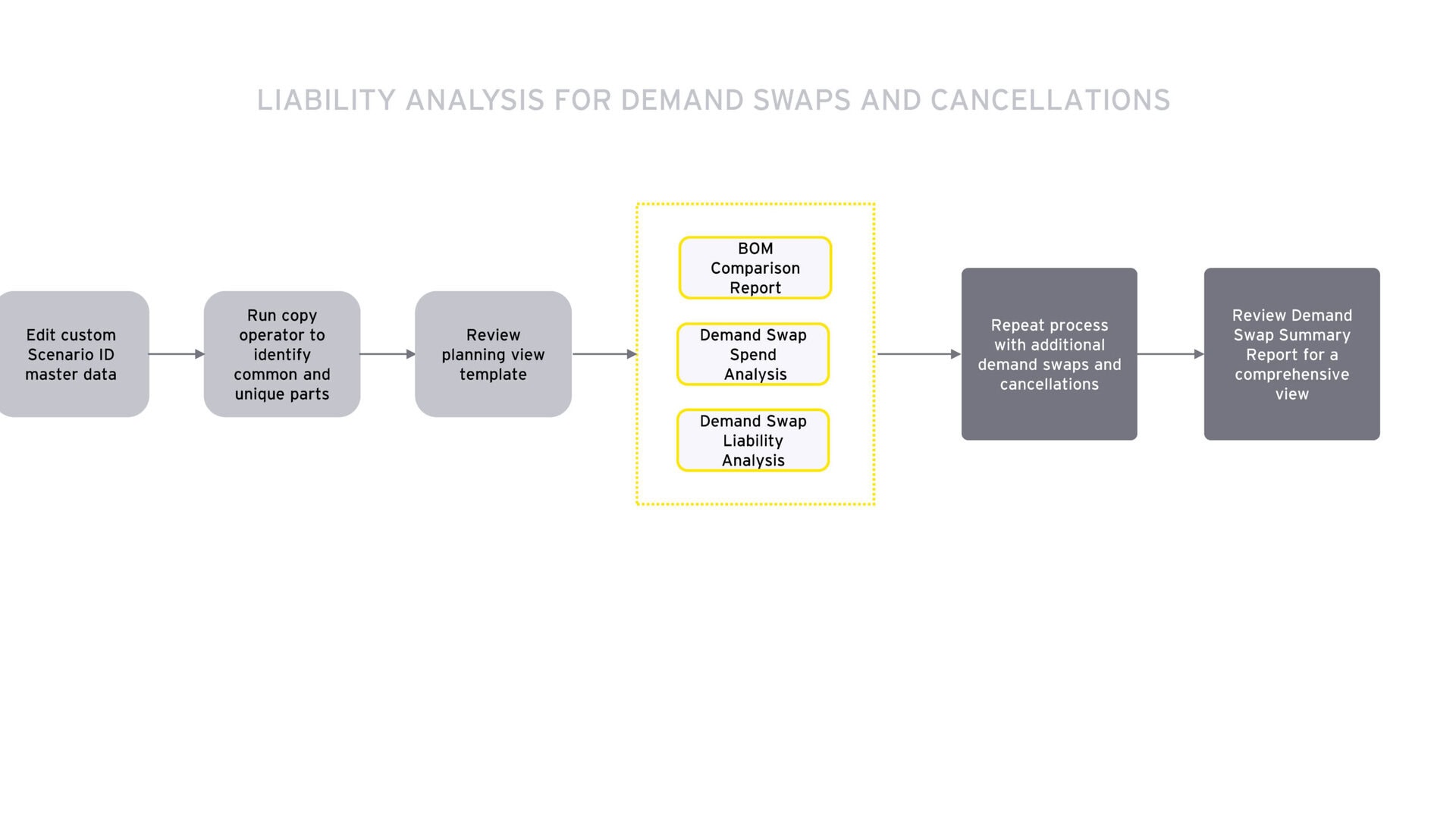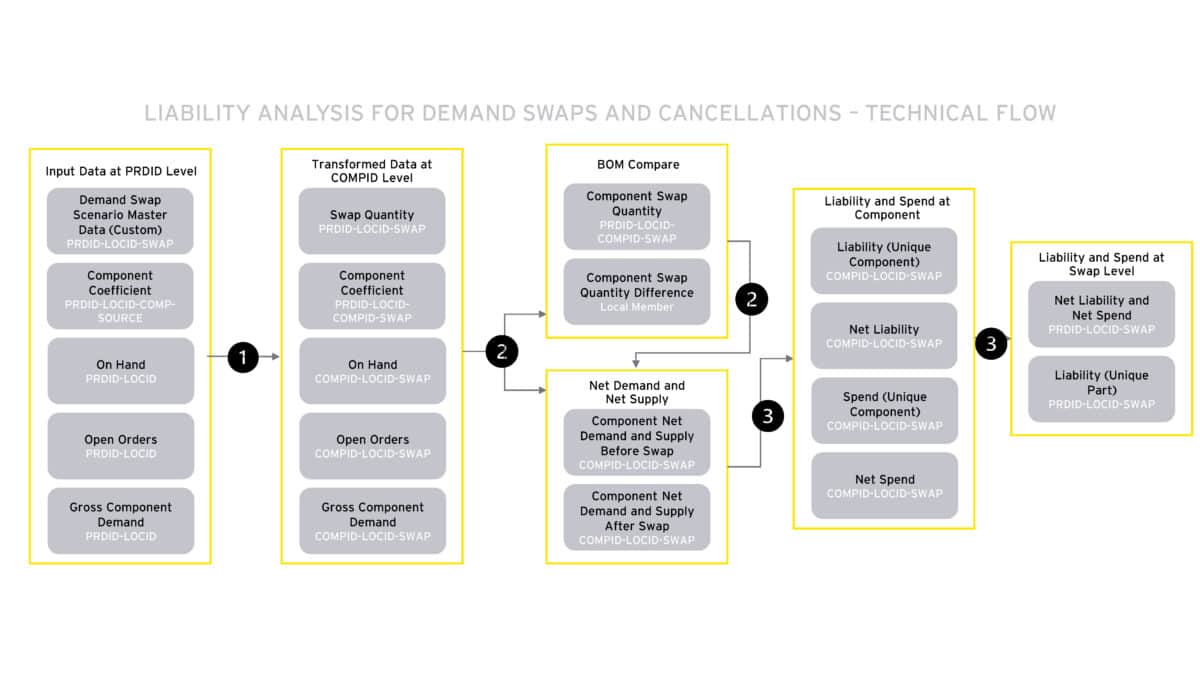Using SAP IBP to Establish an Agentic AI Framework: Three Use Cases


By leveraging these capabilities, companies can move beyond Excel-based models and embrace a future-ready approach. At a Fortune 50 global semiconductor company, this transformation fostered cross-functional collaboration, enabling proactive management of liability and inventory through detailed reporting. Their journey illustrates how, in the future, SAP IBP can serve as the backbone for AI-driven decision-making for all complex supply chains.
The following sections detail each use case, highlight the benefits of a component planning solution, and provide a glimpse into the future of agentic AI frameworks in supply chain planning. These practices, implemented across two successful go-lives, can be broadly adopted by other discrete manufacturing industries.
Graphic: SAP IBP reporting as a backbone for Agentic AI in supply chain planning.
The initial driver for this transformation at the Fortune 50 global semiconductor company was the need to standardize processes across business units and accurately identify liabilities associated with finished goods and components during events such as demand swaps and product cancellations. For example, when a demand swap occurs, demand of a product is moved to a different product or product line; the liability shifts between suppliers and manufacturing sites, creating financial exposures if not accurately tracked. Additionally, the supply chain spans multiple global locations and thousands of SKUs, adding complexity to managing these liabilities at scale. To address this, static inventory reporting reflected demand across different weekly buckets to ensure visibility and alignment across planning horizons.
Liability and portfolio reporting
Historically, liability analysis relies on manual processes and spreadsheet-based models. While familiar, these approaches introduced significant limitations due to huge and complex datasets such as data silos, human error, and lack of real-time visibility. For large and global organizations, where fast decision-making is critical, managing liabilities requires a more robust and scalable solution to reduce costs and create consistent, timely risk mitigation opportunities.
The adoption of IBP for reporting marked a significant turning point, as an entirety of planning data resides in IBP. By centralizing data and automating demand swap and cancellation processes, teams gained access to real-time simulation-based liability reports. These reports improved visibility into potential risks and enabled faster, more informed decisions. The transition involved mapping legacy Excel models into IBP, designing new planning view templates, and integrating with internal data hubs. The transition reduced manual effort and minimized inconsistencies between their reporting and what the contract manufacturers estimated—a common challenge among discrete manufacturing organizations.
Beyond liability, inventory reporting was enhanced through calculation of demand and dollar values across multiple horizons (lead time, 26 weeks, and 51 weeks) while incorporating alternate component adjustments on shortages for risk mitigation. Currently, only “clean alternates” (fully interchangeable components) are supported, but future releases will handle “non-clean alternates” with partial interchangeability, introducing more nuanced substitution logic. IBP also adjusts negative net demand by reallocating excess inventory from alternates, reducing overall liability.

Graphic: Inventory report.
This advanced reporting now supports granular analysis, enabling planners to anticipate shortages and mitigate excess proactively. A key success metric was alignment with CM-provided numbers, eliminating manual reconciliation and building trust in the solution. IBP produces inventory reports that can be easily distributed. These capabilities lay the foundation for future AI enhancements and can be replicated across manufacturing.
The solution empowers teams to take a proactive role in risk management while consolidating reporting into a single tool with comprehensive refresh cycles. Finance and planning users can leverage tailored reports to highlight key metrics and exceptions, while historical databases created in IBP will serve as a foundation for future AI-driven trend analysis.
Scenario planning
Beyond static reporting, liability reporting can be extended to multiple scenarios. Demand swaps occur when demand for one product shifts to another, often due to changes in customer requirements, supply constraints or lifecycle adjustments. Managing these scenarios is complex, requiring analysis of shared and unique components, recalculation of inventory, and assessment of the overall impact on liability (component excess on demand drop) and spend (component requirement from new demand).
Planners initiate demand swaps or cancellations by using custom master data, then running a copy operator to generate the liability reporting in a dedicated planning view template. Detailed analysis can be conducted at the Scenario ID level or summarized in a weekly template that consolidates total liability and spend. The payoff from introducing this reporting was significant; swaps and cancellations that once took hours were now completed in 10 minutes. The concept of Scenario ID also supports multiple demand swaps or cancellations in one single transaction. Planners can review the summary of total spend and liability across multiple transactions at a component level of the individual bill of materials.
Scenario planning is critical for organizations in volatile markets where demand and supply conditions shift rapidly. By simulating a wide range of scenarios, discrete manufacturing companies can evaluate the impact of different business decisions such as launching a new product, discontinuing an existing one, or responding to a sudden supply disruption. This capability strengthens contingency planning and optimizes component allocation.

Graphic: Liability analysis for demand swaps and cancellations.
The IBP solution automates demand swap analysis through three key steps after updating custom master data. The first step is comparing BOMs. IBP identifies shared components, and calculates swap quantities and cost. The second step is calculating demand and excess. IBP recalculates component demand, identifies excess inventory, and estimates liabilities for unique and common parts. The final step is summarizing swaps. IBP consolidates weekly swaps into a single template for total liability and spend visibility.
This automation reduces excess inventory risk, improves component utilization, and accelerates response to market changes. It also lays out the foundation for AI-driven optimizations, such as standardizing components and informing future product design to minimize complexity.

Graphic: Liability analysis for demand swaps and cancellations—technical process.
Future phases in the technical level process for scenario planning in IBP will include implementing risk mitigation strategies such as reallocating excess component numbers beyond the static inventory adjustments. Additionally, results that are exported to SharePoint will be utilized to support ongoing development of an AI-driven framework, enabling predictive insights and further automation. Currently, this is done one swap at a time, but a future phase will allow all swaps and cancellations to be performed at once with a single job run.
By automating previously manual tasks and delivering clear, actionable reports, users quickly adapted to the new process. Flexibility enables analysis of both the same and different products across multiple sites, providing a holistic view of potential outcomes.
Scenario planning supports the Fortune 50 global semiconductor company’s broader business strategy by enabling rapid, data-driven decision-making and risk mitigation. The speed and flexibility of IBP’s scenario planning tools are particularly valuable during periods of high uncertainty, such as during global supply chain disruptions. By enabling rapid scenario analysis, the platform empowers decision-makers to act quickly, minimize adverse impacts, and capitalize on emerging opportunities.
Dashboards and data integration
New dashboards and data integration capabilities provide actionable insights for both planners and finance teams by facilitating collaboration and continuous improvement. By leveraging detailed liability and inventory reporting across current and historical periods, companies can establish a platform for enablement of agentic AI. IBP serves as a rich data source for future AI applications because the system can act autonomously, make decisions, and interact with users in a conversational manner. Using historical data combined with real-time analytics and scenario modeling, AI can drive proactive risk management and optimization.
The dashboards developed within IBP are highly customizable, allowing users to tailor views to their specific needs and preferences. This flexibility ensures that operational planners can quickly identify patterns, outliers, and emerging risks. Data quality is ensured and maintained across integrated systems through rigorous user acceptance testing and ongoing conversations with suppliers. At the Fortune 50 global semiconductor company, future phase work will include enhanced supplier collaboration and reconcile IBP generated risk mitigation plans with site level strategies, further improving alignment and data integrity.
Beyond serving as an input for conversational AI, IBP can also enable predictive analytics. Machine learning models can forecast demand, identify emerging risks, and suggest mitigation strategies. Continuous learning will incorporate new data and feedback to improve accuracy and relevance over time. There is so much potential with AI, helping organizations stay ahead of disruptions, capitalize on opportunities, and drive continuous improvement will be essential going forward. As AI capabilities mature, the integration with IBP will unlock even greater levels of automation, intelligence, and agility.
The transformation of supply chain planning enabled by IBP and advanced AI technologies offers a compelling blueprint for other organizations seeking to enhance their supply chain resilience and agility. By extending IBP beyond traditional planning to include inventory reporting and liability reporting through demand swap analysis and scenario planning, this Fortune 50 global semiconductor company has established a robust platform for agentic AI enablement. The benefits, such as improved visibility, faster decision-making, and proactive risk management, underscore the value of integrating advanced planning tools with AI-driven insights. Most importantly, this unique method of reporting through IBP can be utilized at any discrete manufacturing company.
As the supply chains grow more complex and dynamic, the ability to leverage data, analytics, and AI will be a key differentiator. The journey described in the essay demonstrates that with the right tools, processes, and vision, organizations can transform their supply chain planning and unlock levels of performance and innovation. Future phases for this transformation are looking to reap the benefit by seeking supplier collaboration, advancing risk mitigation, and setting the claims process.
The Fortune 50 global semiconductor company’s journey demonstrates how extending IBP solutions helps to transform supply chain and support agentic AI capabilities into transformations for greater resilience and agility. By integrating advanced liability and inventory reporting, scenario planning, and dynamic dashboards, organizations can achieve near real-time visibility, proactive risk management, and faster decision-making. These innovations not only streamline operations but also lay out the groundwork for future AI-driven enhancements. As supply chains grow more complex, adopting such intelligent frameworks will be essential for staying ahead of disruptions and driving continuous improvement. This blueprint is broadly applicable across various sectors across different industries.
The views expressed in this article are those of the authors and do not necessarily reflect the views of the global EY organization or its member firms.
This article was reviewed by EY Global SCORE (System for Communication Oversight Review and Evaluation): Global SCORE Number EYG no. 009226-25Gbl






